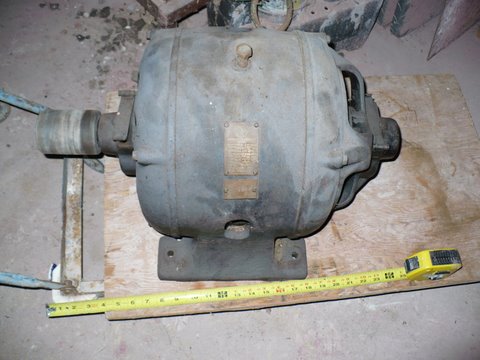A few weeks back, I asked about vintage motors, something that might be an interesting style and/or period match to my circa-1910 Stockbridge shaper (for which I need a motor anyway.)
It was kind of a lark at the time, as I'd narrowly missed what was supposed to have been a nice example- which is what gave me the idea. I soon dropped it for lack of time and sources, and the general disinterest in having a huge old motor of questionable quality shipped all the way to Alaska.
However, I recently happened across this:

Despite the name of the image, it's not a motor off a shaper, that was just a handy name I gave it to keep things sorted in my dump folder. The owner says it's actually out of an old butcher shop that was line-shaft powered.
Here's the data he gave me:
Alternating current motor
Type llTBA single phase 60cycle 3hp cont. duty 40degree C.
25% overload 2 hrs. @55 degrees C.
1750 rpm 110v - 32 amp 220v - 16 amp
Wagner elec mfg co St Louis, USA
He says an electrician friend checked it out- he smelled ozone but it seemed to run okay. I'm assuming worn brushes?
Now, considering this entire thing is purely for looks- a modern 3HP would be far cheaper to ship, more reliable, and a third the size (this one's almost two feet long counting the pulley) - is there any real issue I ought to know about, if I used something like this? Will it draw more power than a modern 3HP? Require an oddball starting circuit? Something else?
Doc.
It was kind of a lark at the time, as I'd narrowly missed what was supposed to have been a nice example- which is what gave me the idea. I soon dropped it for lack of time and sources, and the general disinterest in having a huge old motor of questionable quality shipped all the way to Alaska.
However, I recently happened across this:

Despite the name of the image, it's not a motor off a shaper, that was just a handy name I gave it to keep things sorted in my dump folder. The owner says it's actually out of an old butcher shop that was line-shaft powered.
Here's the data he gave me:
Alternating current motor
Type llTBA single phase 60cycle 3hp cont. duty 40degree C.
25% overload 2 hrs. @55 degrees C.
1750 rpm 110v - 32 amp 220v - 16 amp
Wagner elec mfg co St Louis, USA
He says an electrician friend checked it out- he smelled ozone but it seemed to run okay. I'm assuming worn brushes?
Now, considering this entire thing is purely for looks- a modern 3HP would be far cheaper to ship, more reliable, and a third the size (this one's almost two feet long counting the pulley) - is there any real issue I ought to know about, if I used something like this? Will it draw more power than a modern 3HP? Require an oddball starting circuit? Something else?
Doc.
.png)
Comment